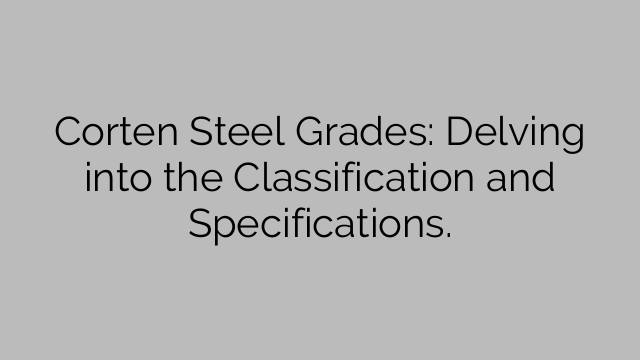But what exactly is Corten steel, and how is it classified? In this article, we will delve into the different grades of Corten steel and explore their specifications and uses.
Corten steel is a group of steel alloys that are designed to rust and develop a protective layer of patina when exposed to the elements. This rust-like appearance not only adds to its beauty but also acts as a protective barrier, preventing further corrosion.
The classification of Corten steel grades is based on the various elements present in its composition. The primary alloying element found in Corten steel is copper, followed by nickel, phosphorus, chromium, and manganese. These alloying elements enhance the weathering properties of the steel, making it more resistant to atmospheric corrosion than standard carbon steel.
The most commonly used Corten steel grades are ASTM A588 and ASTM A242. ASTM stands for the American Society for Testing and Materials, which sets standards and specifications for different materials used in construction and other industries.
ASTM A588 is a high-strength, low-alloy structural steel that is primarily used in outdoor applications such as bridges, buildings, and sculptures. It has a minimum yield strength of 50,000 psi and a minimum tensile strength of 70,000 psi. ASTM A588 is available in different forms, including plates, sheets, bars, and shapes.
On the other hand, ASTM A242 is a low-alloy, high-strength steel that is primarily used in structural applications such as bridges and buildings. It offers similar corrosion resistance to ASTM A588 but has slightly lower mechanical properties. ASTM A242 has a minimum yield strength of 50,000 psi and a minimum tensile strength of 70,000 psi. It is also available in various forms, including plates, sheets, and bars.
Both ASTM A588 and ASTM A242 have excellent weathering properties and are well-suited for outdoor applications. They are often used without the need for additional protective coatings, making them cost-effective and low maintenance options.
In addition to ASTM grades, there are also international equivalents of Corten steel. The most common international standards are EN 10025-5 and JIS G3125 SPA-H. These standards are widely used in Europe and Asia, respectively, and offer similar corrosion resistance and mechanical properties as ASTM grades.
To sum up, Corten steel is classified into different grades based on its composition and specifications. ASTM A588 and ASTM A242 are the most commonly used grades, offering excellent weathering properties and durability. They are widely used in construction and architectural applications, adding a unique aesthetic appeal to various projects. Whether it’s a striking bridge or an eye-catching sculpture, Corten steel grades have proven themselves as a reliable and visually pleasing choice.
[ad_2]

